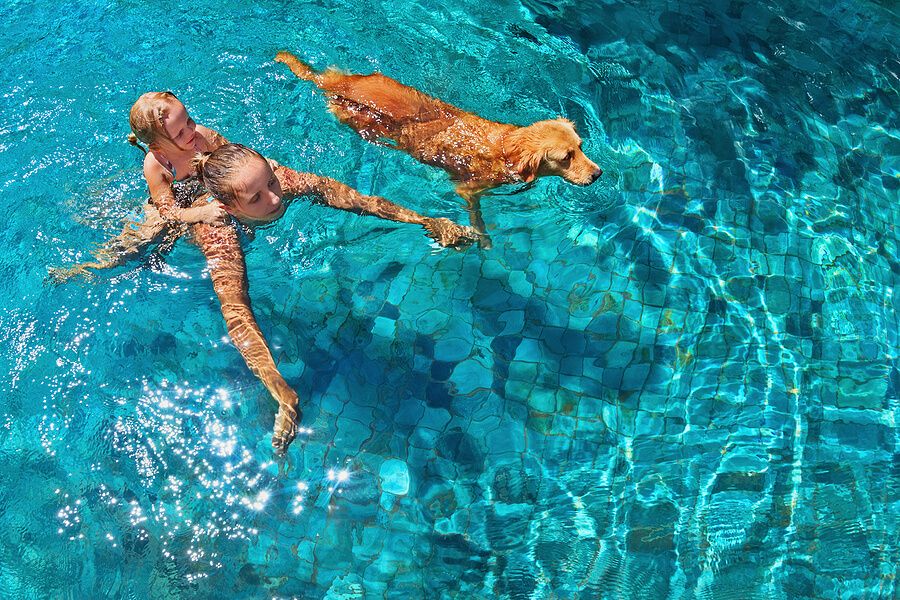Doesrnyour dog love splashing around the water and wagging their tail inrndelight? Swimmingrnisn’trnjust a joyful activity for dogs; it’s a full-body workout thatrnhelps improve cardiovascular health and strengthen muscles. It’s alsorna valuable skill to make their splashing and rolling in the waterrnsafer.

Teachingrnyour dog swimming skills makes a great time for you to build arnstronger emotional bond with your furry friend! But canrnall dogs swim?rnThat’s something not all owners are aware of.
Ifrnthat applies to you, read on to find out your answer and tips onrntraining your dog to swim.
So,
Dorndogs know how to swim?rnIf yes, which ones?
There’srna myth that all dogs know how to swim right from birth. Some may haverna natural tendency to swim and great physical characteristics thatrnmake them better swimmers, but some breeds aren’t born with swimmingrnskills.
Breedsrnthat can swim are:
-
LabradorrntRetrievers: MostrntLabrador Retrievers are born with webbed paws and water-resistantrntcoats. These breeds are generally good at swimming.
-
PortugueserntWater Dog: Thisrntbreed also has webbed paws and waterproof coats. Long ago, therntPortuguese used them for fishing and water rescue.
-
Newfoundland:rntThisrntbreed of dog is larger and is an excellent swimmer. Newfoundlandrntdogs have a water rescue instinct which makes them great lifesavers.rntThey also have physical swimming attributes such as webbed paws andrnta thick double coat.
-
ChesapeakerntBay Retriever: Theyrntare powerful swimmers with retrieving abilities in the water. Theyrntwere originally used for retrieving waterfowl. Chesapeake BayrntRetriever has a water-repelling, dense, oily coat.
Ifrnyour dogisn’t a natural swimmer, doesn’t have swimming-friendly attributes,rnor doesn’t know how to swim, here’s what you must do before jumpingrninto the swim lessons:
-
Graduallyrntintroduce the dog to water so they can feel safe and comfortable
-
Selectrntshallow areas for training the dog
-
Userntpositive reinforcement training to instill confidence in them
-
Neverrntforce them into the water if you see signs of fear or anxiety inrntyour dog
-
Duringrntthe swimming, supervise your dog and, if necessary, take safetyrntmeasures (e.g., a life jacket)
Howrnto Teach A Dog to Swim?
Ifrnyou decide to train your dog in swimming, you must first learn thernbasics. Canrndogs swim in pools?rnOr should I go to the nearest shore? Questions like these might crossrnyour mind. The tips below will help you understand how to teach yourrndog to swim safely.
Choosernthe Right Environment
Whenrnyou’re just starting the lessons, start in a controlled environment.rnYou need a water body like a hydrotherapy pool with no currents orrnwaves. Yourrndog swimming in poolrnis helpful at the beginning when they could easily panicfrom touching the water.
Generally,rndogs can’t see over the edge of the pool. It’s important to place arnlarge object at the exit so they can easily find their way out. Usernsomething like a potted plant or umbrella.
Usingrna ramp instead of steps is better for entering and exiting the water
Offerrnmany rewards and encouragement during the lessons, and continue therntraining patiently.
Yournmight need five to six sessions to introduce water to your dog andrnmake them comfortable. These lessons will help your dog remain calmrnand confident in the water while improving their flexibility at thernsame time.
WhenrnYou Have a Swimming Pool at Home
Manyrnhomes have swimming pools, posing a potential threat to dogs whorncannot swim. Accidents can happen as there won’t always be someone tornwatch the dog.
Teachingrnyour dog to swim is important so they don’t need rescuing whenrnfalling in the pool. As mentioned above, you must introduce your dogrnto the water gradually.
Ifrnpossible, invite a friend who has a dog that can swim pretty well.rnOften dogs get excited and try to swim independently when they seernanother dog having fun in the water. But make sure you supervise thernwhole training.
Trainingrnwith Rewards
Ifrnyou can have another person in this training, this can be enjoyablernfor you and your dog. Ask your helper to hold the dog at the edge ofrnthe pool. Then you go into the water, crossing to the other side.rnOnce you reach the other end, call your dog, showing them a toy orrntreat.
Nowrntell your helper to let go of the dog. For added safety, you can keeprnthe dog on a long leash. In most cases, dogs get tempted to swimrnacross the water for rewards. Once they swim to you, reward them. Tryrnto practice this technique as much as possible to make your dogrnbecome a powerful swimmer.
KeeprnYour Dogs Healthy
Being a pet parent is challenging when your dogs can be sick or injured orrnhave other physical or mental issues. Forever Vets offers manyrnexperienced veterinarians and medical care services for your belovedrndogs. To keep your dogs healthy and happy, schedulernan appointmentoday!
Recent Posts
About Us
At Forever Vets Animal Hospitals, we provide full-service veterinary care across multiple Florida locations, offering a wide range of preventive, diagnostic, surgical, and emergency services for pets. Our team focuses on exceptional care, affordable wellness plans, and creating a welcoming environment for both pets and their owners.
